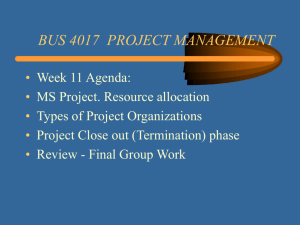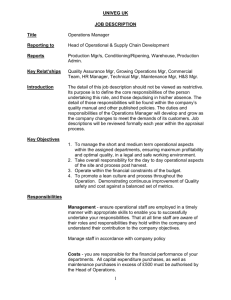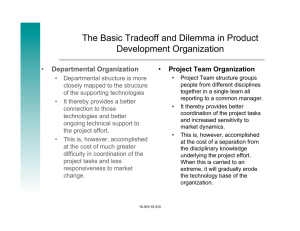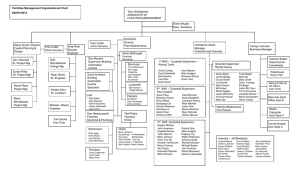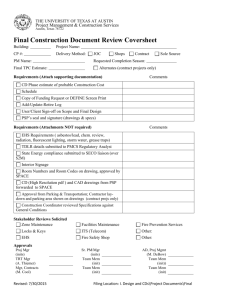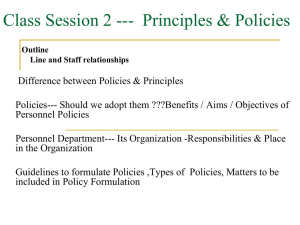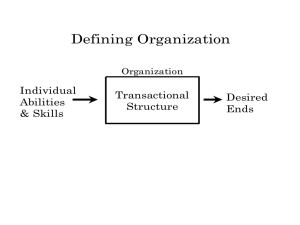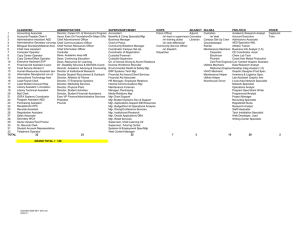PowerPoint Slides for Chapter 3
advertisement
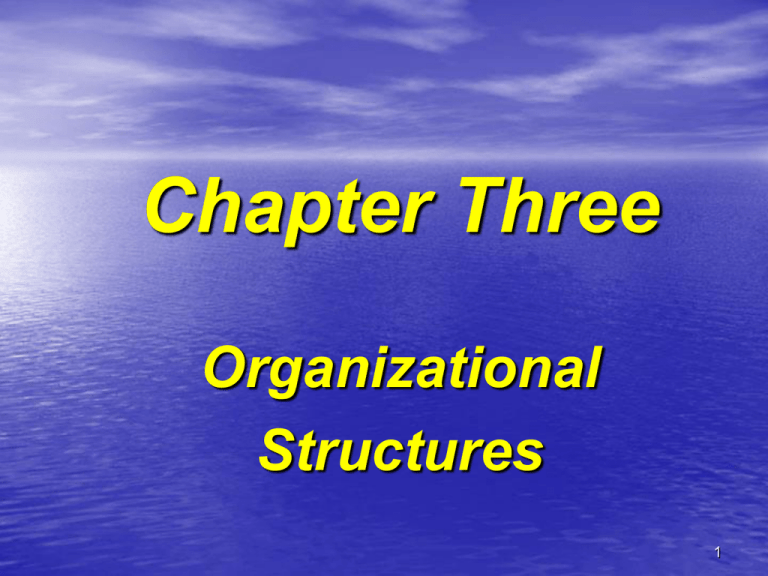
Chapter Three Organizational Structures 1 Types of organizations where projects reside: • Corporations • Government Agencies (EPA, Department of Energy, TSA) • Healthcare institutions • International bodies (World Health Organization, World Trade Organization, UNICEF, etc.) • Professional Associations 2 Organizational Culture • Described by shared values, norms, beliefs, and expectations • Design policies and procedures according to these beliefs • Authority and relationships are defined by culture 3 Project-Based Organizations • Operations consist “primarily” of projects. • Architectural firms, engineering firms, consultants, etc. • Organizations who adopted management of projects ( ex: their finance system is designed to track, control multiple projects) 4 Non-project based organizations • Projects are invisible in the organization • Have classical management structure • Departmental division of work 5 The Functional Structure General Manager Director Level Engineering Production Sales Marketing AdminisAdmin. tration Division Level Project coordination Department Level Section Level x x Functional Responsibility x 6 Functional Structure Advantages • Easier budgeting and cost control are possible • Better technical control is possible • Specialists can be shared • Personnel can be used on many different projects. 7 Advantages (Continued) • It provides continuity in the functional disciplines; policies, procedures • Lines of responsibility are easily defined and understandable. 8 Functional Structure Disadvantages • No one individual is directly responsible for the total project (i.e., no formal authority; committee solutions). • It does not provide the project-oriented emphasis necessary to accomplish the project tasks. • Coordination becomes complex, and additional lead time is required for approval of decisions. 9 Disadvantages (Continued) • Decisions normally favor the strongest functional groups. • There is no customer focal point. • Response to customer needs is slow. 10 Departmental Project Management Division Manager Department X Project Leaders Section Level Department Y Project Leaders Section Level Department Z Project Leaders Section Level 11 Project Expeditor ENGINEERING DIVISION LIAISON DEPT. PIPING HVAC CHEMICAL DRAFTING legend Formal authority / reporting flow Informal authority / reporting flow 12 Project Coordinator (Line-Staff organization) LEGEND DIVISION MGR. FORMAL FLOW PROJECT MGR. INFORMAL FLOW DEPT. MANAGER DEPT. MANAGER 13 Project Coordinator Weaknesses • Shared authority with upper management. • Line-staff project managers who reported to a division head did not have any authority or control over those portions of a project in other divisions; that is, the project manager in the engineering division cannot direct activities in the manufacturing division. 14 Pure Project (Projectized) Structure General Manager Project coordination Project B Manager Project A Manager ENG. MFG. ENG. MFG. Project C Manager ENG. MFG. 15 Projectized Structure Advantages • Complete line authority over the project • The project participants work directly for the • • • project manager. Strong communications channels. Staffs can maintain expertise on a given project without sharing key personnel. Rapid reaction time is provided. 16 Advantages (Continued) • A focal point develops for out-of-company customer relations • Interface management becomes easier as unit size is decreased. 17 Projectized Structure Disadvantages • Cost of maintaining this form • Duplication of effort, facilities, and personnel; inefficient usage • Tendency to retain personnel on a project long after they are needed. 18 Disadvantages (Continued) • No share of Technology • There is a lack of career continuity and opportunities for project personnel. 19 20 The Matrix Management Structure General Manager Project Mgr. X Project Mgr. Y Project Mgr. Z Functional Responsibility Engineering Operations Finance Others Project Responsibility 21 Matrix Development • Horizontal as well as vertical channels must exist for making commitments. • There must be quick and effective methods for conflict resolution. • There must be good communication channels and free access between managers. 22 Matrix Development (Continued) • All managers must have input into the planning process. • Both horizontally and vertically oriented managers must be willing to negotiate for resources. • The horizontal line must be permitted to operate as a separate entity except for administrative purposes. 23 Matrix Structure Advantages • Policies and procedures can be set up independently for each project • Rapid responses are possible • Each person has a “home” after project completion. • Because key people can be shared, the program cost can be minimized 24 Matrix Structure Advantages (Continued) • Authority and responsibility are shared • Stress is distributed among the team (and the functional managers) 25 Matrix Structure Disadvantages • • • • • Multidimensional information flow. Multidimensional work flow. Dual reporting. Continuously changing priorities. Management goals different from project goals. • Potential for continuous conflict and conflict resolution. • Difficulty in monitoring and control. 26 The Strong Matrix Structure (With a Director of Project Management) General Manager Director: Project Mgmt. Director: Engineering Director: Manufacturing Director: Finance/Admin. Project Mgr. X Project Mgr. Y Project Mgr. Z 27 Composite Organization • Most organizations have all of these structures at various levels called composite organization Ex: New product development with a skunks work team (HP disk drives) 28 PMO • Can exist in any organizational form • Can have advisory influence or • Can have formal grant authority • PM directly reports to PMO 29 Which Structure Is Best For Project Management? 30 Factors For Selecting An Organizational Form • • • • Project size Project length Project management experience Philosophy and visibility of executives • Project location • Available resources • Unique aspects of the project 31
